Quick Start Guide for Omada Controller
CHAPTERS
1. Determine the Network Topology
2. Install Omada Controller Software
3. Inform the EAPs of the Controller Host’s Address
4. Start and Log In to the Omada Controller
5. Create Sites and Adopt EAPs
6. Monitor and Manage the EAPs
|
|
This guide applies to: Omada Controller 2.6.0. |
Omada Controller is a management software for TP-Link EAP devices. With this software, you can use a web browser to centrally manage your EAP devices, such as configure EAPs in batches and conduct real-time monitoring of EAPs.
This guide introduces how to complete the basic settings of Omada Controllers:
1. Determine the network topology
2. Install Omada Controller software
3. Inform the EAPs of the Controller Host’s Address
4. Start and Log In to the Omada Controller
5. Create Sites and Adopt the EAPs
6. Monitor and Manage the EAPs
The following parts detailedly introduces these steps.
1Determine the Network Topology
There are two kinds of network topologies to centrally manage EAPs via Omada Controller:
Omada Controller and EAPs are in the same subnet.
Omada Controller and EAPs are in different subnets.
Determine your management method according to your need and refer to the following introductions to build your network topology.
1.1Management in the Same Subnet
If your Omada Controller and EAPs are in the same subnet, refer to the following network topology.
A router acts as a DHCP server to assign IP addresses to EAPs and clients. Omada Controller should be installed on one host, which is called as Controller Host. The other hosts in the same LAN can access the Controller Host to manage the network. Taking the following topology as an example, you can enter “192.168.0.100:8043“ in a web browser on Host B to visit the Omada Controller interface on Host A. It’s recommended to set a static IP address to the Controller Host for the convenient login to the Omada Controller interface.
Figure 1-1 Network Topology
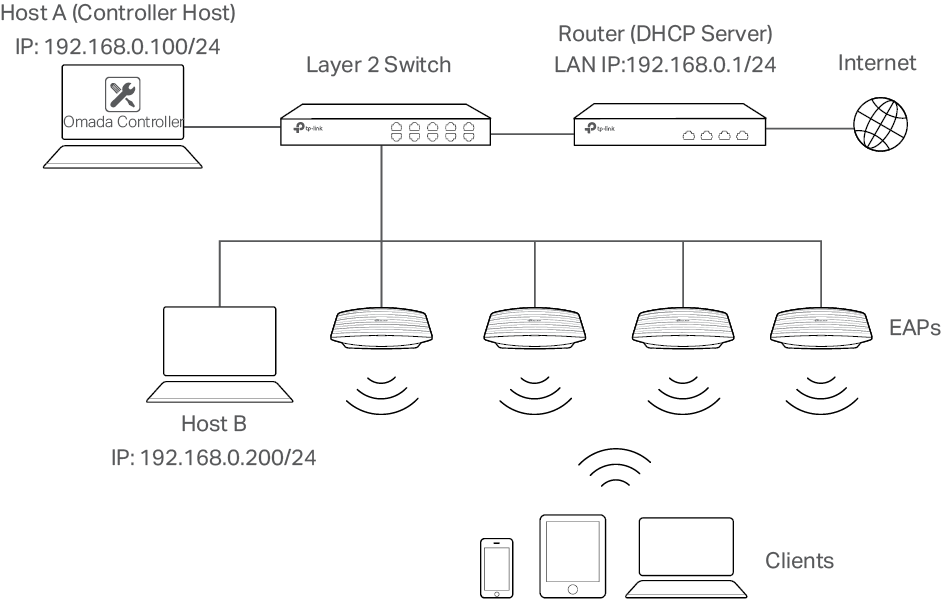
|
|
Note: •Omada Controller must be running all the time when you manage the network. •Omada Controller can be running on only one host in a LAN. When other users in the LAN try to launch Omada Controller on their own hosts, they will be redirected to the host that is already running Omada Controller. |
1.2Management in Different Subnets
If your Omada Controller and EAPs are in different subnets, refer to the following topology.
A router acts as the gateway of the network. A layer 3 switch acts as a DHCP server to assign IP addresses to EAPs and clients. The Controller Host and the EAPs are connected to the switch’s different network segments. To help EAPs find the Controller Host, EAP Discover Utility should be installed on Host B which is in the same subnet with the EAPs. For how to use EAP Discovery Utility, refer to Inform the EAPs of the Controller Host’s Address.
Figure 1-2 Network Topolog
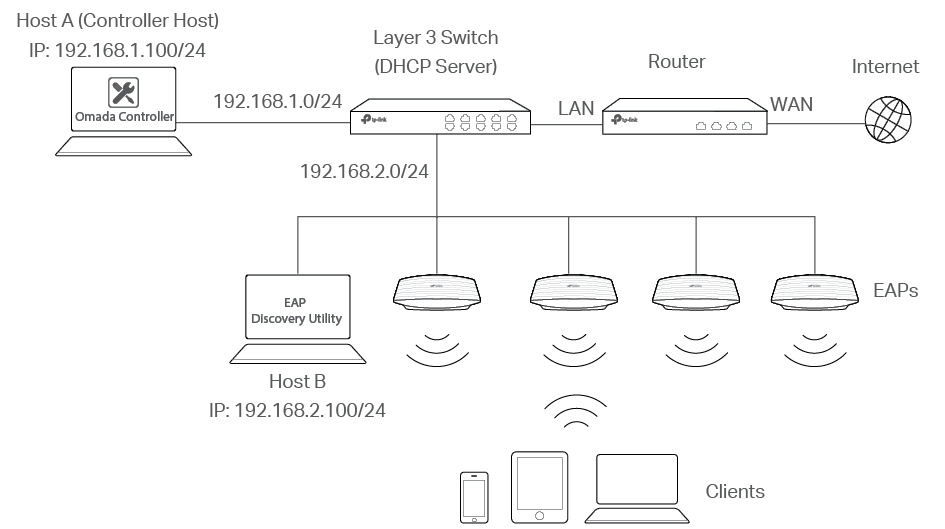
2Install Omada Controller Software
Make sure your PC meets the following system requirements and then properly install the Omada Controller software.
System Requirements
Operating System: Microsoft Windows 7/8/10/Server.
Web Browser: Mozilla Firefox 32 (or above), Google Chrome 37 (or above), Opera 24 (or above), or Microsoft Internet Explorer 11 (or above).
|
|
Note: We recommend that you deploy Omada Controller on a 64-bit operating system to guarantee the software stability. |
Install Omada Controller
Download the installation file of Omada Controller from the website https://www.tp-link.com/en/download/EAP-Controller.html. Then follow the instructions to properly install the Omada Controller software. After successful installation, a shortcut icon of the Omada Controller will be created on your desktop.
3Inform the EAPs of the Controller Host’s Address
If your Controller Host and EAPs are in the same network segment, you can skip this section.
If your Controller Host and EAPs are in different subnets, you need to install EAP Discovery Utility on a host that is in the same network segment with the EAPs. EAP Discovery Utility can help EAPs find the Controller Host.
System Requirements
Windows 7/8//10/Server
Mac OS X 10.7/10.8/10.9/10.10/10.11
Install and Use EAP Discovery Utility
Follow the steps below to install EAP Discovery Utility and use it to inform the EAPs of the Controller Host’s IP address:
1)Download the installation file from the website https://www.tp-link.com/en/download/EAP-Controller.html#EAP_Discovery_Tool. Then follow the instructions to properly install EAP Discovery Utility.
2)Open the EAP Discovery Utility and the following window will pop up. This window shows the information of all EAPs in the same LAN.
Figure 3-1 The Page of the EAP Discovery Utility
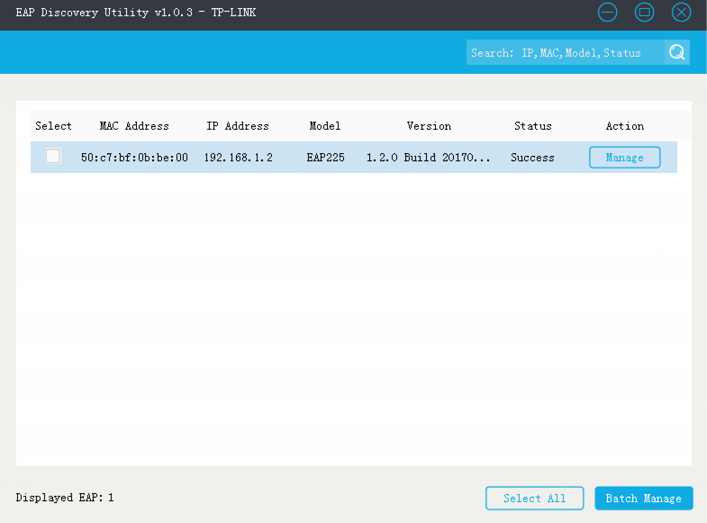
3)Click Manage in the Action column or select multiple EAPs and click Batch Manage.
Figure 3-2 Managing EAPs
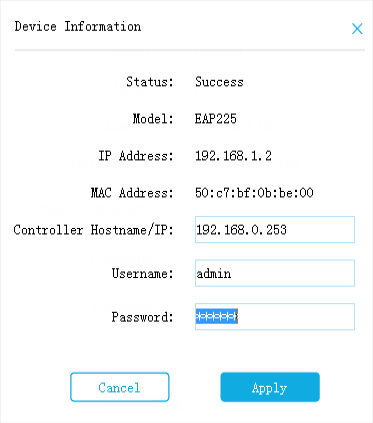
4)Enter the hostname or IP address of the Controller Host.
5)Enter the EAP’s username and password (both are admin by default).
6)Click Apply to inform the EAP of the Controller Host’s hostname or IP address. And then the connection can be established between the EAP and the Controller Host.
4Start and Log In to the Omada Controller
Launch Omada Controller and follow the instructions to complete the basic configurations, and then you can log in to the management interface.
4.1Launch Omada Controller
Double click the icon and the following window will pop up. You can click Hide to hide this window but do not close it. After a while, your web browser will automatically open.
Figure 4-1 Launching Omada Controller
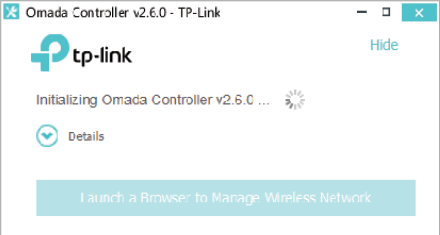
|
|
Note: If your browser does not open automatically, click Launch a Browser to Manage Wireless Network. You can also launch a web browser and enter http://127.0.0.1:8088 in the address bar. If your web browser opens but prompts a problem with the website’s security certificate, click Continue. Only one Omada Controller can run in a LAN. If an Omada Controller has already been running on a host that is in your LAN, you will be redirected to the Omada Controller interface on that host. |
4.2Do the Basic Configurations
In the web browser you can see the configuration page. Follow the setup wizard to complete the basic settings for Omada Controller.
1)The setup page displays all the detected EAPs in the network. Select one or more EAPs to be managed and click Next.
Figure 4-2 Selecting the EAPs to be managed
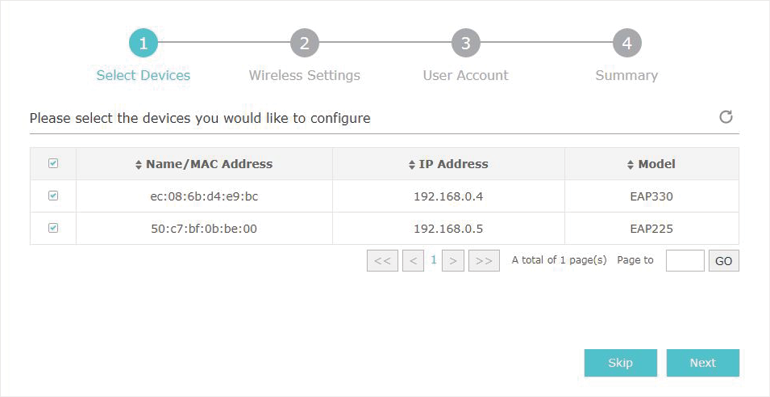
2)Set an SSID name (wireless network name) and password for the EAPs to be managed. Omada Controller will create two wireless networks, a 2.4GHz one and a 5GHz one, both encrypted in WPA2-PSK mode. Click Next.
Figure 4-3 Setting an SSID Name and Password
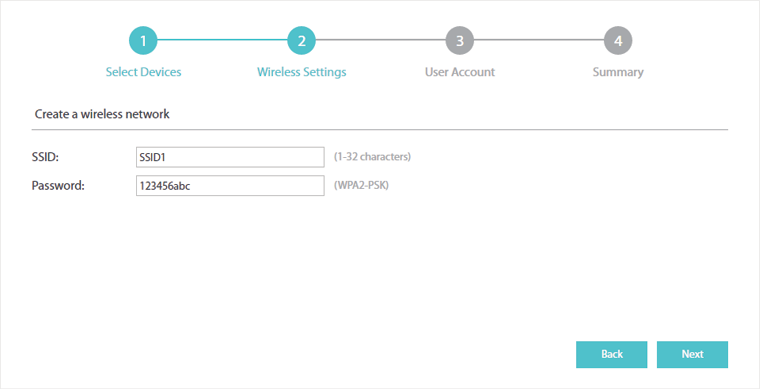
3)Specify a username and password to create an administrator account. Specify the email address to receive the notification emails and reset your password if necessary. Click Next.
Figure 4-4 Creating an Administrator account
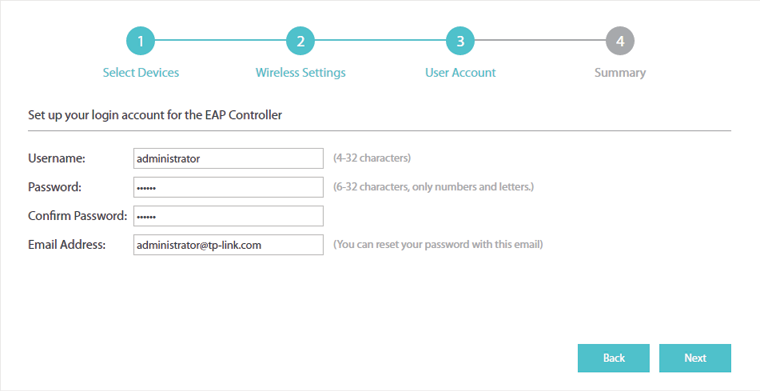
|
|
Note: After logging into Omada Controller, set a mail server so that you can receive notification emails and reset your password in case that you forget the password. Please refer to Configure Mail Server. |
4)Review your settings and click Finish.
Figure 4-5 Reviewing the Setting
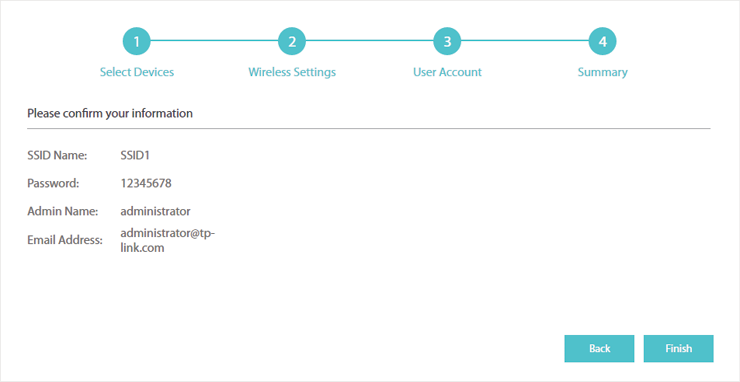
4.3Log In to the Management Interface
Once the basic configurations are finished, the browser will be redirected to the following page. Log in to the management interface using the username and password you have set in the basic configurations.

|
|
Note: In addition to the Controller Host, other hosts in the same LAN can also manage EAP devices via remote access to the Controller Host. For example, if the IP address of the Controller Host is 192.168.0.100 and Omada Controller is running normally on this host, you can enter https://192.168.0.100:8043/login, or https://192.168.0.100:8043, or http://192.168.0.100:8088 in the web browser of other hosts in the same LAN to log in to the Omada Controller and manage EAP devices. |
Omada Controller can manage multiple EAP networks, which are called sites. Multiple sites are logically separated, and each site has its own configurations. There is an initial site named Default. If you have no need to manage EAPs with different sites, you can use the default site and skip the Create Sites section. However, Adopt the EAPs is a necessary step to manage the EAPs.
Follow the steps below to add sites.
1)Click in the top left corner of the page and select
, and then the following window will pop up.
Figure 5-1 Configuring Sites
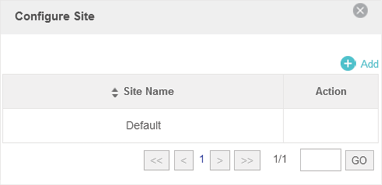
2)Click and set a name for the site.
Figure 5-2 Adding a Site
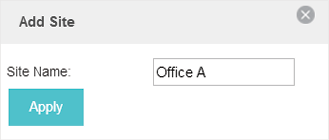
3)Click Apply to create the site.
Omada Controller can discover all EAP devices currently connected in the network and display their connection status. All EAPs are in Pending status when first discovered by Omada Controller. To manage the EAPs, you need to adopt them. In the quick setup process, Omada Controller will automatically adopt the selected EAPs using the default username and password (both are admin). However, if you have changed the username or password of your EAPs before, Omada Controller cannot automatically adopt the them, and you need to refer to the following steps to adopt them manually.
To ensure that all EAPs are adopted, follow the steps below:
1)Select a site and go to Access Points > Pending. The table displays all the EAPs that have not been adopted.
Figure 5-3 The Page of the Pending EAP

2)Click the Retry button in the Action column and enter the current username and password of the EAP. Click Apply.
Figure 5-4 Adopting the EAP manually
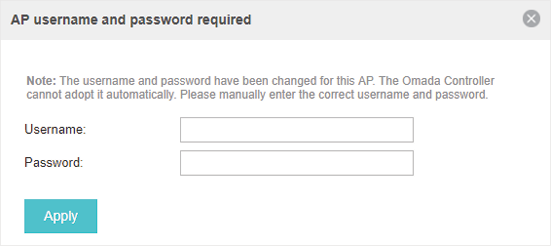
|
|
Tips: 1. If you have a new discovered EAP, you can click the Adopt button in the Action column to adopt the EAP. Omada Controller will automatically adopt the EAP using the default username and password (both are admin). 2. If you have multiple new discovered EAPs, and all of them have the default username and password (both are admin), you can click the Batch Adopt button to adopt them in batch. But if there are any EAPs with the Retry button, it means that the username and password of these EAPs have been changed. You need to first adopt them before batch adopt the rest EAPs. |
3)After EAPs are adopted, the status will change from Pending to Connected. All the EAPs’ username and password will become the same as those of the Controller’s administrator account you created in the basic configurations. Refer to Do the Basic Configurations.
|
|
Tips: If you want to change the EAPs’ username and password, refer to Device Account. |
When all the configurations above are finished, you can centrally monitor and manage the EAPs via the Omada Controller’s management interface. The management interface is divided into three sections as the following figure shows.
Figure 6-1 The Management Interface of Omada Controller
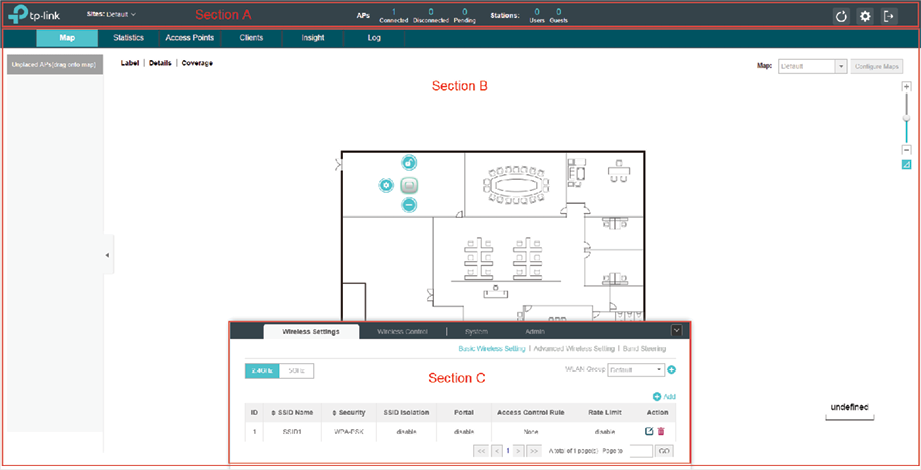
|
Section A |
In Section A, you can check the status of EAPs and clients in the network. Also, you can click Furthermore, the Sites allows you to group your EAPs and manage them in batches. To configure sites, refer to Create Sites. |
|
Section B |
In Section B, you can centrally monitor and manage the EAPs and clients. |
|
Section C |
In Section C, you can globally configure the wireless network. The global configurations will take effect on all the adopted EAPs. |